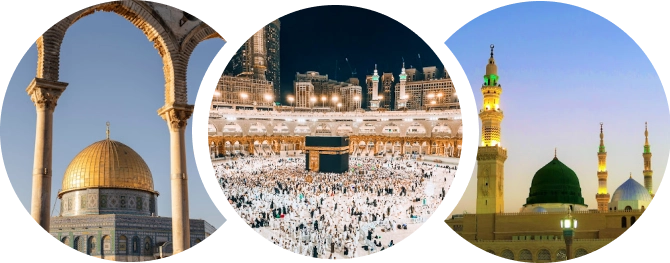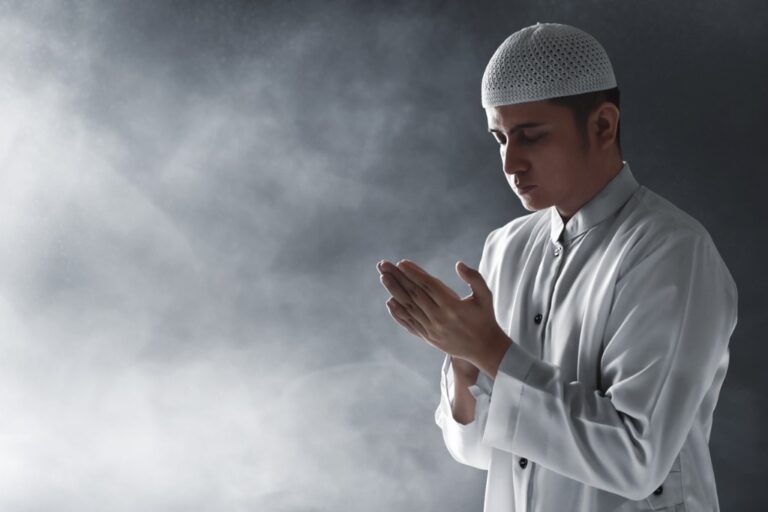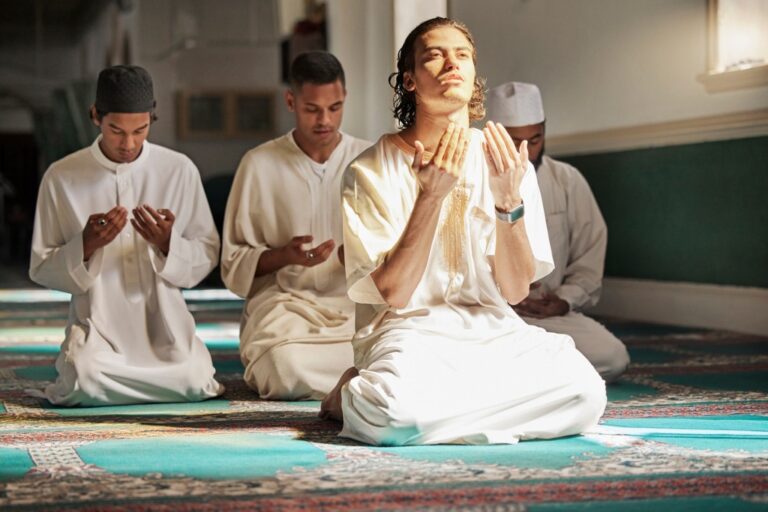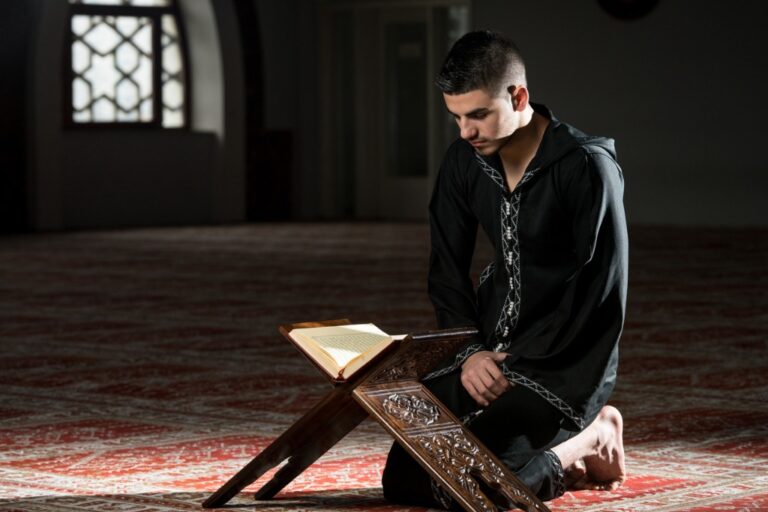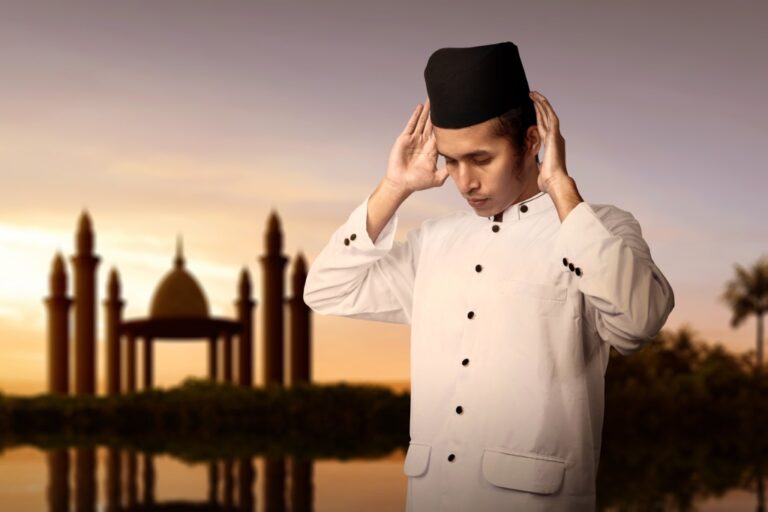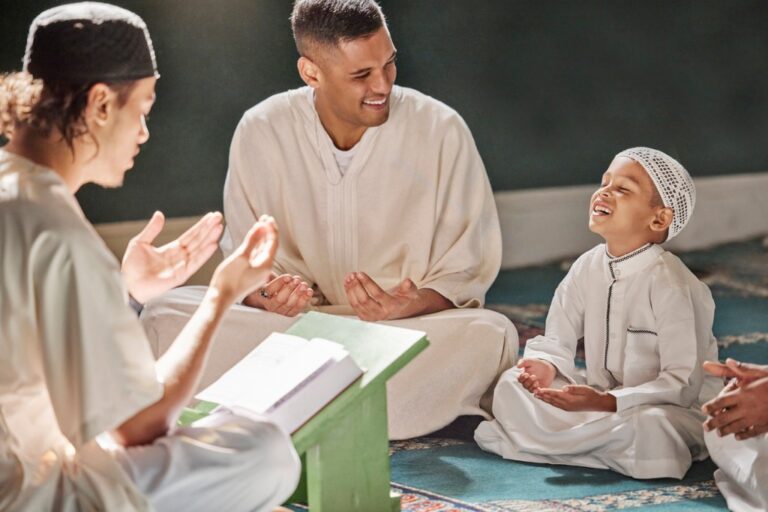How to Perform Wudu
Are you new to Islam and wondering how to correctly perform Wudu – an essential part of your faith? In simple terms, Wudu is a vital cleansing ritual that purifies the body before prayer.
This user-friendly guide will walk you through a step-by-step process, making it easy to understand and follow this sacred act of purification. Let’s dive in and learn more about this beautiful practice that is essential for every Salah!
Understanding Wudu: Its Meaning and Significance in Islam
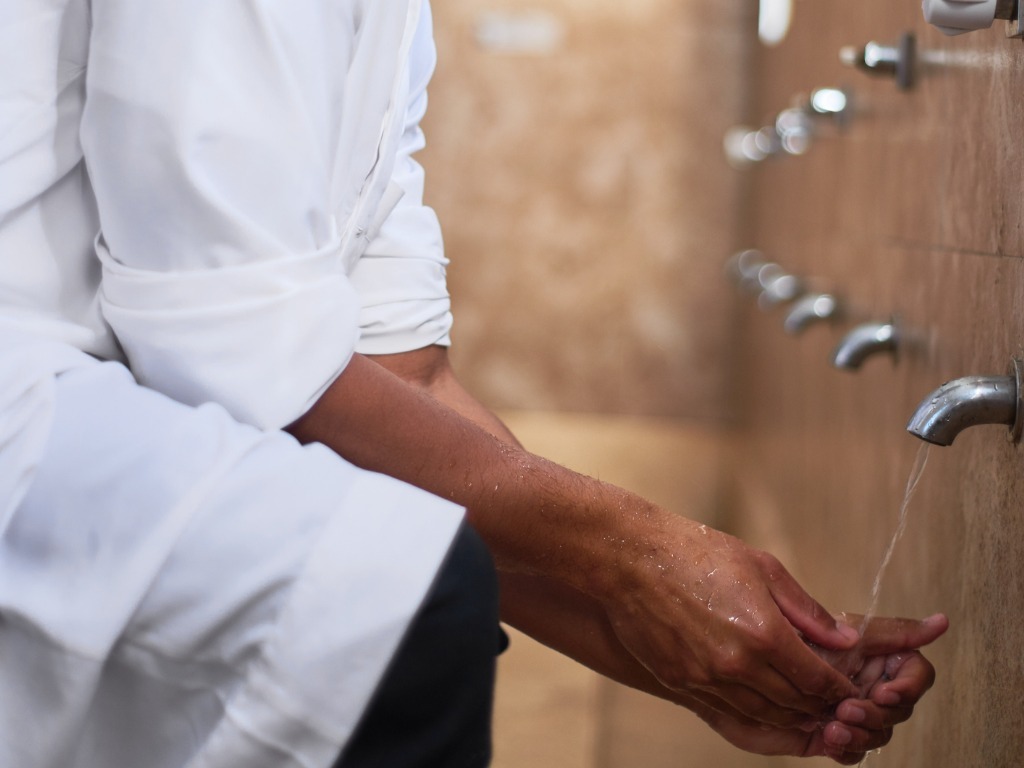

Wudu, also known as ablution, plays a fundamental role in the Islamic faith. It is a purifying cleansing ritual that prepares Muslims for prayer (Salah) and other acts of worship. “Wudu” originates from the Arabic root word ” wađāˀah,” which means to cleanse or purify.
During Wudu, you wash specific body parts with clean water, following the order prescribed in the Quran and the Sunnah.
It’s more than just a physical cleaning; Wudu holds profound spiritual importance as it helps you feel closer to Allah SWT when you worship. It brings you to a state of purity, making you feel more humble, calm, and devoted during your prayers.
Wudu is a sign of both physical and spiritual cleanliness. Through this practice, you can seek forgiveness for minor sins and ensure you approach Allah SWT with a pure heart and body.
So, Wudu is an important part of Salah, and Islamic teaching says that you can’t perform Salah without it. Prophet Muhammad PBUH has said:
مِفْتَاحُ الْجَنَّةِ الصَّلاَةُ وَمِفْتَاحُ الصَّلاَةِ الْوُضُوءُ ” .”
“The key to Paradise is Salat and the key to Salat is Wudu.” (Source: Jami` at-Tirmidhi 4)
Conditions of Performing Wudu
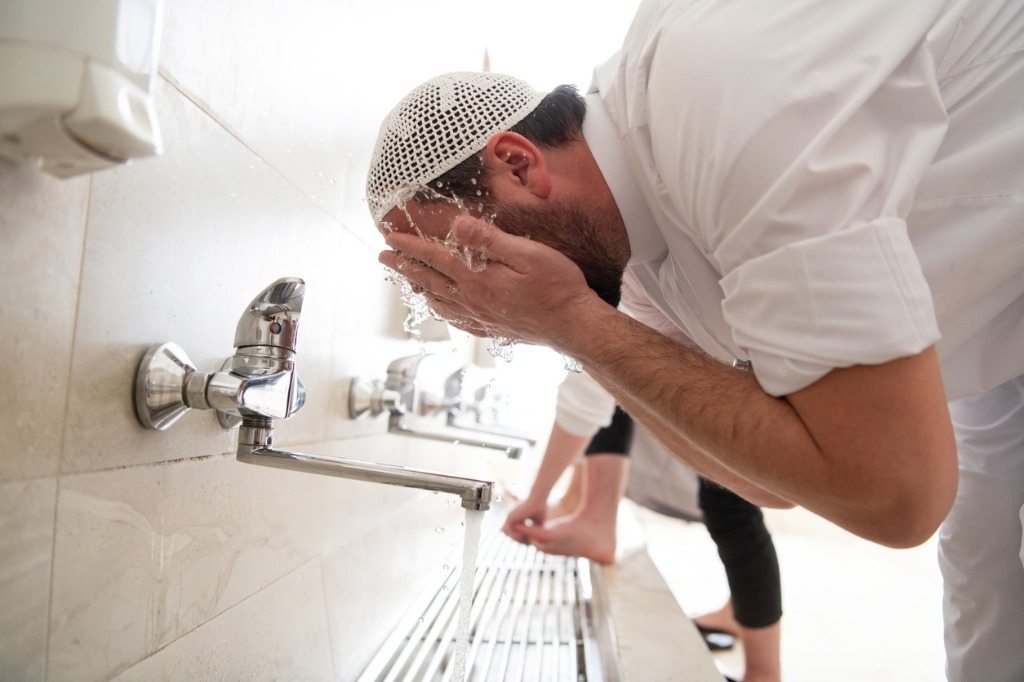


The requirements for performing Wudu differ between men and women in Islam.
Differences (if any) between men and women in Wudu
In the Islamic faith, the act of Wudu or ablution holds equal significance for both men and women as a purifying cleansing ritual. It is a prerequisite for specific acts of worship like Salah (prayer) and reading the Qur’an.
However, there is no notable distinction between males and females regarding how this process should be performed.
Both genders follow identical steps, such as
- Making Niyyah (intention),
- Start Wudu in the name of Allah, i.e Say Bismillah
- Washing hands three times,
- Rinsing water into mouth and nose,
- Washing the face and arms
- Wiping the head and ears,
- Followed by washing feet up to ankles.
Even though women and men have much in common, some things can affect their Wudu differently. For example, women who have used nail polish should know that it forms a layer that keeps water from getting to their nails during Wudu, which most schools of Sunni Islam law say could make Wudu invalid.
Another thing that only happens to women is that they have natural discharges. According to Islamic teachings, if this happens, the Wudu is no longer clean, and the person needs to do it again before doing things like praying or handling the Quran, which you can only do after Wudu.
Step-by-Step Guide on How to Perform Wudu
The step-by-step guide on how to perform Wudu includes preparation for the ritual and detailed steps with images.
Preparation for ablution
Before beginning the Wudu ritual, ensure all conditions for a successful ablution are met. This includes having clean water and being in a suitable location, preferably quiet and clean.
Begin with your Niyyah, or intention, to perform Wudu solely for Allah SWT’s sake. After this, you need to say “Bismillah” (in the name of Allah SWT) before beginning the physical cleansing process. Sunan Abi Dawud 101
Remember that every action you take during this preparatory stage is significant within the Islamic faith because it sets the tone for this sacred act of worship.
Detailed steps with images
Here is a step-by-step guide on how to perform Wudu properly:
- Begin by expressing your intention (Niyyah) to perform Wudu for Allah SWT’s sake.
- To center yourself and begin the ritual, say Bismillah (in Allah SWT’s name).
- Begin by washing your hands three times, first with your right and then with your left.


- Swish water around in your mouth three times before spitting it out.
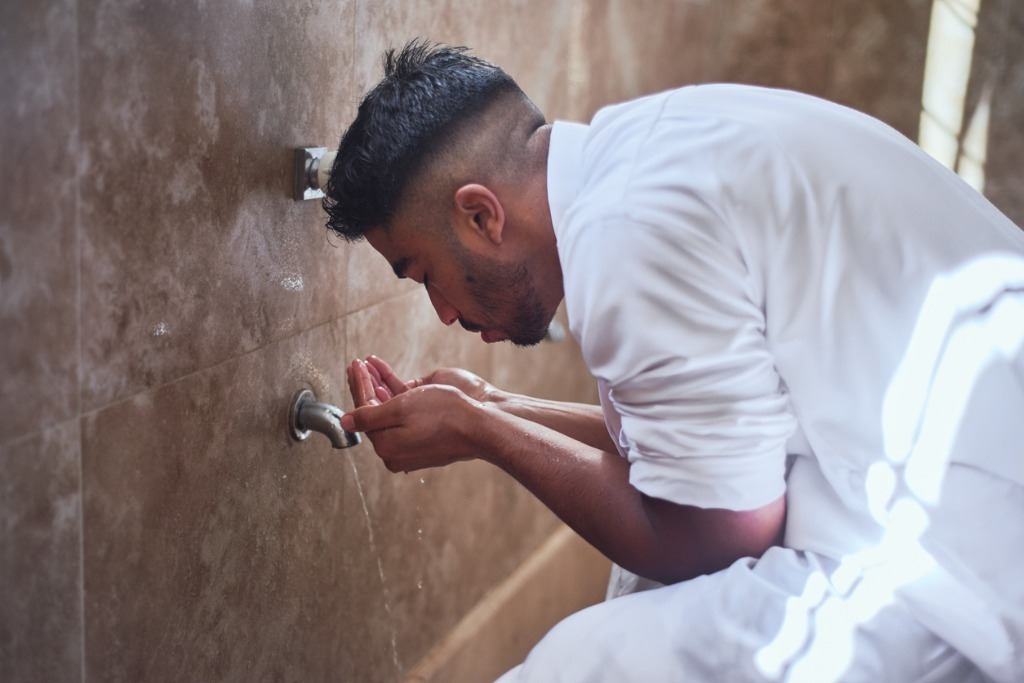

- Inhale water through your nose and exhale three times. If you cannot inhale water, wet your fingers and wipe the lower part of your nostrils.


- Wash your face three times, starting from the right ear and working down to the chin.



- Wash your arms up to the elbow, ensuring no part is left dry. Start with the right hand, then move to the left hand.
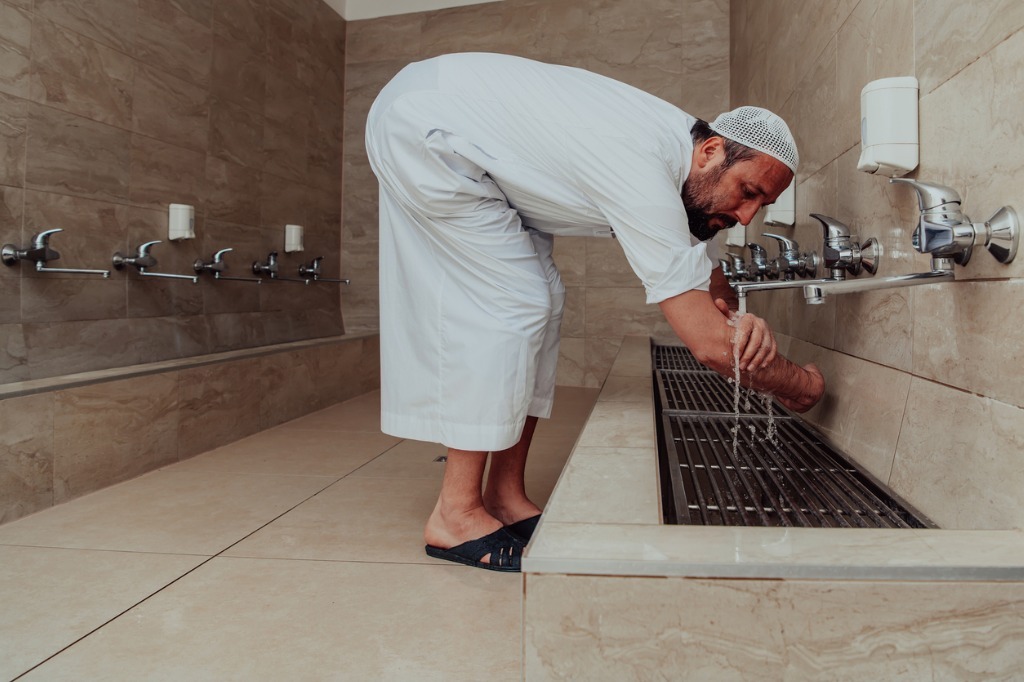

- Wipe your head gently from the forehead to the back of your head, then from the back of your head to the forehead again. Partial wipe is also accepted as per Muslim scholars.


- Clean behind your ears by running wet fingers from bottom to top.
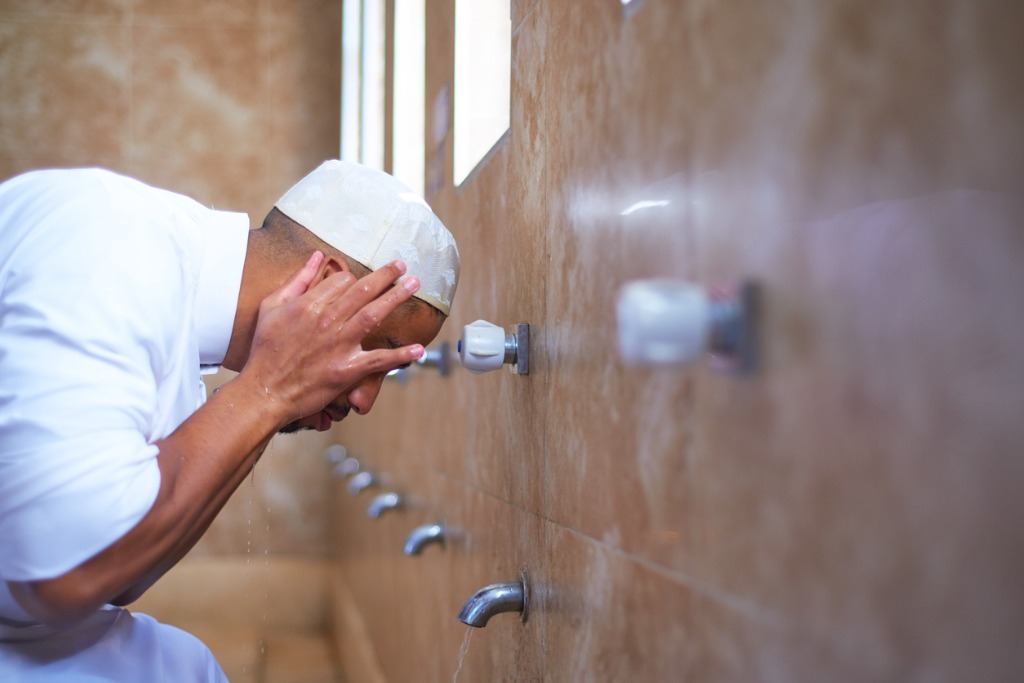

- Finally, thoroughly wash your feet (up to ankles) three times, beginning with your right foot and ending with your left foot.


Dua After Wudu
- After completing Wudu, it is recommended to say a specific phrase in Arabic: “Ashhadu an la ilaha ill-Allah wahdahu la sharika lah, wa ashhadu anna Muhammadan ‘abduhu wa rasuluhu.”
- This phrase translates to “I bear witness that there is no god but Allah SWT alone, with no partner or associate, and I bear witness that Muhammad is His servant and Messenger.”
Prophet Muhammad told us the benefit of reciting this Dua; he said: “All the eight gates of Paradise will be opened for him (the one who recites this Dua), and he may enter through any gate he wishes.” (Reference: Bulugh al-Maram 57)
Benefits of Performing Wudu
Performing Wudu holds several benefits for individuals. These benefits include:
- Spiritual Cleansing: Wudu cleanses the soul and heart of impurities, allowing a person to approach prayer with a clear mind and focused intention.
- Physical Hygiene: Wudu entails washing various body parts, including the hands, face, and feet. This physical cleansing aids in the removal of dirt and germs from the body, promoting good hygiene.
- Disease Prevention: Washing hands frequently during Wudu can help prevent disease spread by removing pathogens that may be on the hands.
- Skin Health: The act of washing different parts of the body during Wudu can aid in maintaining healthy skin by removing excess oils, sweat, and dead skin cells.
- Mental Focus: You can mentally prepare for worship by performing Wudu before prayer. During prayer, the process promotes mindfulness and concentration.
These benefits highlight how performing Wudu has religious significance and promotes physical cleanliness and mental well-being.
What the Quran Says About Wudu
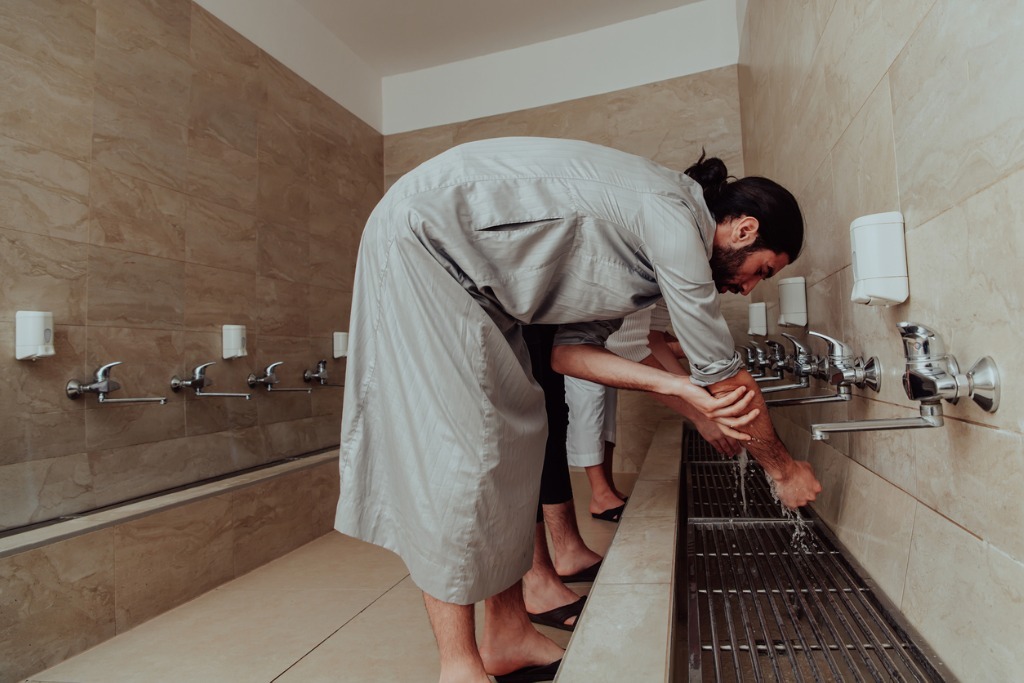

The Quran emphasizes the importance of performing Wudu before prayer and guides how to perform it. In Surah Maidah Ayah 6, Allah SWT says,
“O you who have believed, when you rise to [perform] prayer, wash your faces and your forearms to the elbows and wipe over your heads and wash your feet to the ankles.”
This verse specifies which body parts should be washed during Wudu: the face, arms up to the elbows, wiping over the head, and feet up to the ankles.
Additionally, in Surah An-Nisa Ayah 43, Allah SWT instructs believers saying:
“O you who have believed! Do not approach prayer while intoxicated until you know what you are saying..”
This verse emphasizes an essential aspect of Wudu: Before praying, one must be physically and mentally pure.
How Prophet Muhammad (PBUH) Performed Wudu
The Prophet Muhammad (PBUH) performed Wudu by washing each body part three times, following a specific order. Sunan Ibn Majah 417
Hadiths related to Wudu
The Hadiths, which are the sayings and actions of Prophet Muhammad (PBUH), provide necessary guidance on performing Wudu correctly. The Hadiths describe the steps involved in ablution, such as washing one’s face, arms, head, and feet.
For example, Abu Hayyah R.A. narrated the following about Wudu. He said that he saw Ali R.A performing the ablution, and at the end of the ablution, Ali R.A said: ” I wanted to show you how the Messenger of Allah SWT (ﷺ) performed ablution.” Sunan Abi Dawud 116
Hadiths also specify the conditions for specific Wudu actions, such as wiping socks or shoes. They are an essential source for Muslims to learn and practice the correct method of performing this purifying cleansing ritual.
How to Teach Children About Wudu
Teaching children about Wudu is an essential part of their Islamic education. By explaining the significance and steps of this purifying ritual, we can help them develop a strong connection with their faith. Here are some practical ways to teach children about Wudu:
- Demonstrate the practical steps: Explain the purpose and significance of each stage of Wudu to your children. Make it a hands-on learning experience by encouraging them to observe and participate.
- Use visuals: Visual aids such as diagrams or illustrations can help children understand the various parts of Wudu. Create colorful posters or flashcards that demonstrate each step in a fun and engaging way.
- Read age-appropriate books: Look for children’s books that explain Wudu in simple terms and with appealing illustrations. Reading these books with your child will not only educate them but will also spark meaningful discussions.
- View educational videos: Many online resources provide animated videos that explain how to perform Wudu. Watching these videos with your child can be a fun way to teach them about this important ritual.
- Cooperative practice: Set aside time each day for you and your child to practice Wudu together. This will allow them to put what they’ve learned into practice and reinforce their understanding of the steps involved.
- Consider the following: Discuss with your child why Muslims perform Wudu before prayer. Explain how it cleanses the body and the soul, allowing them to approach prayer with clarity and focus.
- Connect it to prayer: Discuss how performing ablution prepares us for worshiping Allah SWT to emphasize the connection between Wudu and prayer. Encourage your child to tie their understanding of Wudu to their daily prayers.
- Make it an enjoyable activity: Make learning about Wudu more enjoyable by incorporating games or quizzes. For example, you could make a game in which your child must match the steps of Wudu with their corresponding pictures, or you could quiz them on the significance of Wudu.
- Encourage questions: Provide a safe environment for your child to ask Wudu-related questions. Answer their questions patiently and provide age-appropriate explanations to help them understand better.
- Set a good example: Regularly practicing Wudu as a parent or guardian sets an excellent example for your child. You will inspire your children to perform Wudu if you also do it with sincerity.
Common Questions About Wudu
In the following section, we will answer some frequently asked questions using authentic Ahadith.
Does burping break Wudu?
Burping does not break Wudu. According to Islamic teachings, activities that invalidate ablution include urination, defecation, flatulence, deep sleep, menstruation, and sexual intercourse.
To provide additional clarity, there is a hadith about passing gas:
“لاَ وُضُوءَ إِلاَّ مِنْ صَوْتٍ أَوْ رِيحٍ”
“There no Wudu except for a sound or a smell.”
It means your Wudu is valid if you don’t hear a sound or smell.
As a result, burping is not considered one of these activities and thus does not negate Wudu. To perform the ritual correctly and maintain their purity for prayer, Muslims must first understand the conditions under which Wudu is broken.
Does shower count as Wudu?
Showering can count as Wudu if performed to remove impurities. This means that if you take shower to purify yourself before prayer, you can fulfill the Wudu requirements if you make the intention.
However, it is essential to note that you should still perform the individual Wudu steps, such as washing your face and limbs, while in the shower. Ablution would not be accomplished with a simple rinse under the tap.
So, taking a full cleansing shower to purify can be considered a valid form of Wudu before prayer.
Can I do Wudu with socks?
Sometimes, you are permitted to wipe over socks or shoes during ablution. To do this, ensure the socks or shoes have been worn after a complete ablution, including foot washing.
During travel, you can extend this concession to three days, allowing you to repeat it multiple times on the same day. This can be especially beneficial if you have limited access to proper ablution facilities or have long working hours.
However, remember that this practice has specific conditions and should not replace regularly washing your feet during ablution. So, follow the guidelines and perform ablution properly according to Islamic teachings.
What breaks your Wudu?
Specific actions or conditions can break one’s Wudu, requiring them to perform it again before they can pray. Some of these actions include:
- Passing urine, feces, or gas (releasing wind from the anus). Sahih al-Bukhari 135
- Sexual discharge from the penis or vagina (madhi and sexual vaginal discharge). Musnad Ahmad 893
- Deep sleep makes a person completely unaware of their surroundings (if buttocks are not firmly seated on the floor). Sunan Abi Dawud 203
- Loss of consciousness due to various reasons (insanity, fainting, drunkenness, or some medicines).
- Touching the sexual organ with the bare hand (for both men and women). Sunan Ibn Majah 481
For women specifically, menstruation and postnatal bleeding also invalidate Wudu. It is important to note that these are just some examples, and additional factors may nullify Wudu according to different schools of jurisprudence within Islam.
The Role of Wudu in Strengthening Muslim Identity
Performing Wudu plays a significant role in strengthening the Muslim identity.
- Performing Wudu is a significant act of worship that helps you strengthen your faith and commitment to Allah SWT.
- It is a ritual that emphasizes the importance of cleanliness and purity in Islamic teachings, especially before engaging in the worship acts.
- By regularly performing Wudu, you demonstrate your dedication to following the principles of the Fiqh (Islamic jurisprudence) and the example of Prophet Muhammad (PBUH).
- Wudu is not just a physical cleansing but also allows you a moment for introspection and repentance. It provides an opportunity to seek Allah SWT’s forgiveness for any sins you may have committed, enhancing your spiritual connection with Him. In a narration, Prophet Muhammad PBUH said: “When a Muslim man performs ablution, his sins are removed from his hearing, his sight, his hands, and his legs. If he sits down, he will sit down forgiven.” (Reference: Musnad Aḥmad 21680)
- By performing Wudu, you establish a meaningful connection with Allah SWT and enhance your devotion during Salah (prayer).
Additionally, following the specific requirements of Wudu, as Islam prescribes, cultivates discipline and self-control in your daily life.
Conclusion
Performing Wudu is vital for you as a Muslim, as it is a purifying ritual before prayer. By understanding the steps and significance of this practice, you can strengthen your identity and connection to Allah SWT.
It’s essential to follow the guidance from the Quran and Hadiths while addressing questions about Wudu. Teaching children about Wudu from a young age will help them develop a strong foundation in their faith.
Embracing Wudu as an integral part of your daily routine can bring you closer to your faith and enhance your relationship with Allah SWT.
FAQs
What is Wudu, and why is it important?
The Islamic practice of Wudu is to wash certain parts of the body before prayer. It’s important because it cleans and purifies a person’s spirit and lets them pray cleanly.
What are the steps of performing Wudu?
In order to do Wudu, you have to wash your hands, rinse your mouth and nose, wash your face, wash your forearms, wipe your head with wet hands, and then wash your feet.
Can I perform Wudu if water is not readily available?
If you are sick, in a place where you can’t get clean water, or might not be able to get water easily, you can do Tayammum (dry ablution) with clean soil or dust.
How long does Wudu last? Do I need to repeat it for each prayer?
Wudu lasts until something breaks it, like going to the bathroom, passing gas, falling asleep, losing consciousness, etc. It doesn’t have to be repeated for every regular prayer while it’s still valid unless something makes it no longer valid. But some people may do Wudu again before each prayer to feel more spiritually clean and focused.
كيفية الوضوء
هل أنت جديد في الإسلام وتتساءل عن كيفية أداء الوضوء بشكل صحيح - وهو جزء أساسي من إيمانك؟ بعبارات بسيطة، الوضوء هو أحد طقوس التطهير الحيوية التي تنقي الجسم قبل الصلاة. سيرشدك هذا الدليل سهل الاستخدام خلال عملية خطوة بخطوة، مما يجعل من السهل فهم ومتابعة عمل التطهير المقدس هذا. هيا بنا نتعمق ونتعلم المزيد عن هذه الممارسة الجميلة الضرورية لكل صلاة!فهم الوضوء: معناه وأهميته في الإسلام


شروط الوضوء



الاختلافات (إن وجدت) بين الرجل والمرأة في الوضوء
في العقيدة الإسلامية، يحمل الوضوء أو الوضوء أهمية متساوية لكل من الرجال والنساء باعتباره طقوس تطهير. وهي شرط أساسي لعبادات معينة مثل الصلاة وقراءة القرآن. ومع ذلك، لا يوجد تمييز ملحوظ بين الذكور والإناث فيما يتعلق بكيفية يجب أن تتم هذه العملية. يتبع كلا الجنسين خطوات متماثلة، مثل- عقد النية
- ابدأ الوضوء بسم الله، أي قل بسم الله
- غسل اليدين ثلاث مرات
- شطف الفم والأنف بالماء
- غسل الوجه والذراعين
- مسح الرأس والأذنين
- يلي ذلك غسل القدمين حتى الكاحلين.
دليل خطوة بخطوة حول كيفية أداء الوضوء
< span style="font-weight: 400;">دليل خطوة بخطوة حول كيفية أداء الوضوء يتضمن التحضير للطقوس و خطوات تفصيلية باستخدام الصور.الاستعداد للوضوء
قبل البدء في طقوس الوضوء، تأكد من استيفاء جميع شروط الوضوء الناجح. ويشمل ذلك الحصول على مياه نظيفة والتواجد في مكان مناسب، ويفضل أن يكون هادئًا ونظيفًا. ابدأ بنيتك، أو نيتك، بالوضوء فقط لوجه الله سبحانه وتعالى. بعد ذلك عليك أن تقول "بسم الله" قبل البدء بعملية التطهير الجسدي. سنن أبي داود 101 تذكر أن كل إجراء تقوم به خلال هذه المرحلة التحضيرية له أهمية كبيرة في العقيدة الإسلامية لأنه يحدد نغمة هذه العبادة المقدسة.الخطوات التفصيلية مع الصور
إليك دليل خطوة بخطوة حول كيفية أداء الوضوء بشكل صحيح: فترة>- ابدأ بالتعبير عن نية الوضوء في سبيل الله.
- لتتمركز وتبدأ الطقوس قل بسم الله.
- ابدأ بغسل يديك ثلاث مرات، أولًا بيمينك ثم بيدك اليسرى.


- تمضمض بالماء في فمك ثلاث مرات قبل أن يبصقه.


- استنشق الماء من خلال أنفك وأخرج الزفير ثلاث مرات. إذا لم تتمكن من استنشاق الماء، بلّل أصابعك وامسح الجزء السفلي من أنفك.


- اغسل وجهك ثلاث مرات، بدءًا من الأذن اليمنى وحتى الذقن.



- اغسل ذراعيك حتى المرفق، وتأكد من عدم ترك أي جزء جافًا. ابدأ باليد اليمنى، ثم انتقل إلى اليد اليسرى.


- امسح رأسك بلطف من الجبهة إلى مؤخرة رأسك، ثم من خلف رأسك إلى الجبهة مرة أخرى. كما يتم قبول المسح الجزئي حسب رأي علماء المسلمين.


- نظف خلف أذنيك عن طريق تمرير أصابعك المبللة من الأسفل إلى الأعلى.


- وأخيرًا، اغسل قدميك جيدًا (حتى الكاحلين) ثلاث مرات، بدءًا من قدمك اليمنى وانتهاءً بقدمك اليسرى.


دعاء بعد الوضوء
- بعد الانتهاء من الوضوء، يوصى بقول عبارة محددة باللغة العربية: ""أشهد أن لا إله إلا الله وحده لا شريكة له، وأشهد أنا محمد عبده"" ورسوله."
- تترجم هذه العبارة إلى "أشهد أن لا إله إلا الله وحده لا شريك له، وأشهد أن محمدًا عبده ورسوله". ماسنجر."
فوائد الوضوء
للوضوء فوائد عديدة للأفراد. تشمل هذه الفوائد ما يلي:- التطهير الروحي: الوضوء ينظف النفس والقلب من الشوائب، مما يسمح للإنسان أن يقترب من الصلاة بعقل صافي ونية مركزة.< /سبان>
- النظافة الجسدية: يتضمن الوضوء غسل أجزاء مختلفة من الجسم، بما في ذلك اليدين والوجه والقدمين. يساعد هذا التطهير الجسدي في إزالة الأوساخ والجراثيم من الجسم، وتعزيز النظافة الجيدة.
- الوقاية من الأمراض: يمكن أن يساعد غسل اليدين بشكل متكرر أثناء الوضوء في منع انتشار المرض عن طريق إزالة مسببات الأمراض التي قد تكون على اليدين.
- صحة الجلد: يمكن أن يساعد غسل أجزاء مختلفة من الجسم أثناء الوضوء في الحفاظ على صحة الجلد عن طريق إزالة الزيوت الزائدة والعرق والشوائب. وخلايا الجلد الميتة.
- التركيز الذهني: يمكنك الاستعداد ذهنيًا للعبادة من خلال الوضوء قبل الصلاة. أثناء الصلاة، تعمل العملية على تعزيز اليقظة والتركيز.
ماذا يقول القرآن عن الوضوء
كيف توضأ النبي محمد (ص)
توضأ النبي محمد (صلى الله عليه وسلم) بغسل كل جزء من جسده ثلاث مرات بأمر معين. سنن ابن ماجه 417أحاديث متعلقة بالوضوء
الأحاديث، وهي أقوال وأفعال النبي محمد (صلى الله عليه وسلم)، توفر الإرشادات اللازمة لأداء الوضوء بشكل صحيح. تصف الأحاديث خطوات الوضوء، مثل غسل الوجه والذراعين والرأس والقدمين. على سبيل المثال، أبو حية ر.أ. روى ما يلي عن الوضوء. قال: رأيت علياً يتوضأ، فلما انتهى من الوضوء قال علي رضي الله عنه: أردت أن أريكم كيف توضأ رسول الله صلى الله عليه وسلم. سنن أبي داود 116 كما حددت الأحاديث شروط الوضوء مثل مسح الجوارب أو الأحذية. فهي مصدر أساسي للمسلمين لتعلم وممارسة الطريقة الصحيحة لأداء طقوس التطهير هذه.كيفية تعليم الأطفال عن الوضوء
يعد تعليم الأطفال عن الوضوء جزءًا أساسيًا من تعليمهم الإسلامي. ومن خلال شرح أهمية وخطوات طقوس التطهير هذه، يمكننا مساعدتهم على تطوير علاقة قوية بإيمانهم. فيما يلي بعض الطرق العملية لتعليم الأطفال عن الوضوء:- وضح الخطوات العملية: اشرح الغرض من كل مرحلة من مراحل الوضوء وأهميتها لأطفالك. اجعلها تجربة تعليمية عملية من خلال تشجيعهم على الملاحظة والمشاركة.
- استخدم العناصر المرئية: يمكن أن تساعد الوسائل المرئية مثل الرسوم البيانية أو الرسوم التوضيحية الأطفال على فهم الأجزاء المختلفة من الوضوء. أنشئ ملصقات أو بطاقات تعليمية ملونة توضح كل خطوة بطريقة ممتعة وجذابة.
- اقرأ الكتب المناسبة لعمرك: ابحث عن كتب الأطفال التي تشرح الوضوء بعبارات بسيطة وبرسوم توضيحية جذابة. إن قراءة هذه الكتب مع طفلك لن تؤدي إلى تعليمه فحسب، بل ستثير أيضًا مناقشات هادفة.
- عرض مقاطع الفيديو التعليمية: توفر العديد من الموارد عبر الإنترنت مقاطع فيديو متحركة تشرح كيفية أداء الوضوء. يمكن أن تكون مشاهدة مقاطع الفيديو هذه مع طفلك طريقة ممتعة لتعليمه هذه الطقوس المهمة.
- الممارسة التعاونية: خصص وقتًا كل يوم لك ولطفلك لممارسة الوضوء معًا. سيسمح لهم ذلك بوضع ما تعلموه موضع التنفيذ وتعزيز فهمهم للخطوات المعنية.
- ضع في اعتبارك ما يلي: ناقش مع طفلك سبب قيام المسلمين بالوضوء قبل الصلاة. اشرح كيف يطهر الجسد والروح، مما يسمح لهم بالتعامل مع الصلاة بوضوح وتركيز.
- ربطه بالصلاة: ناقش كيف يهيئنا الوضوء لعبادة الله سبحانه وتعالى للتأكيد على العلاقة بين الوضوء والصلاة. شجع طفلك على ربط فهمه للوضوء بصلواته اليومية.
- اجعله نشاطًا ممتعًا: اجعل تعلم الوضوء أكثر متعة من خلال دمج الألعاب أو الاختبارات. على سبيل المثال، يمكنك إنشاء لعبة حيث يجب على طفلك مطابقة خطوات الوضوء مع الصور المقابلة لها، أو يمكنك اختباره حول أهمية الوضوء.
- شجع الأسئلة: وفر بيئة آمنة لطفلك لطرح الأسئلة المتعلقة بالوضوء. أجب عن أسئلتهم بصبر وقدم تفسيرات مناسبة لأعمارهم لمساعدتهم على الفهم بشكل أفضل.
- كن قدوة جيدة: إن ممارسة الوضوء بانتظام كوالد أو وصي يعد مثالًا ممتازًا لطفلك. سوف تلهم أطفالك لأداء الوضوء إذا قمت بذلك أيضًا بإخلاص.
أسئلة شائعة حول الوضوء
في القسم التالي، سنجيب على بعض الأسئلة الشائعة باستخدام الأحاديث الصحيحة.هل التجشؤ ينقض الوضوء؟
التجشؤ لا ينقض الوضوء. وفقًا للتعاليم الإسلامية، تشمل الأنشطة التي تبطل الوضوء التبول والتغوط وانتفاخ البطن والنوم العميق والحيض والجماع. ولمزيد من الوضوح هناك حديث عن إخراج الغازات: "لاَ وُضُوءَ إِلاَّ مِنْ صَوْتٍ أَوْ رِيحٍ" "لا وضوء إلا بصوت أو رائحة." يعني أن وضوئك صحيح إذا لم تسمع صوتًا أو رائحة. ونتيجة لذلك فإن التجشؤ لا يعتبر من هذه الأنشطة وبالتالي لا ينفي الوضوء. لأداء الطقوس بشكل صحيح والحفاظ على طهارتهم للصلاة، يجب على المسلمين أولاً فهم الظروف التي ينتهك فيها الوضوء.هل يعتبر الاستحمام بمثابة الوضوء؟
يمكن اعتبار الاستحمام بمثابة الوضوء إذا تم إجراؤه لإزالة الشوائب. وهذا يعني أنك إذا استحممت لتطهير نفسك قبل الصلاة، فيمكنك تحقيق متطلبات الوضوء إذا نويت. ومع ذلك، من الضروري ملاحظة أنه لا يزال يتعين عليك أداء خطوات الوضوء الفردية، مثل غسل وجهك وأطرافك، أثناء الاستحمام. ولا يتم الوضوء بمجرد الشطف تحت الصنبور. لذلك، فإن الاستحمام الكامل للتطهير يمكن اعتباره شكلاً صحيحًا من الوضوء قبل الصلاة.هل أستطيع الوضوء بالجوارب؟
في بعض الأحيان يجوز لك المسح على الجوارب أو الأحذية أثناء الوضوء. للقيام بذلك، تأكد من ارتداء الجوارب أو الأحذية بعد الوضوء الكامل، بما في ذلك غسل القدمين. يمكنك أثناء السفر تمديد هذا الامتياز إلى ثلاثة أيام، مما يسمح لك بتكراره عدة مرات في نفس اليوم. يمكن أن يكون هذا مفيدًا بشكل خاص إذا كان وصولك إلى مرافق الوضوء المناسبة محدودًا أو إذا كان لديك ساعات عمل طويلة. ومع ذلك، تذكر أن هذه الممارسة لها شروط معينة ولا ينبغي أن تحل محل غسل قدميك بانتظام أثناء الوضوء. لذا، اتبع الإرشادات وتوضأ بشكل صحيح وفقًا للتعاليم الإسلامية.ما الذي ينقض وضوئك؟
يمكن لأفعال أو شروط معينة أن تنقض الوضوء، مما يتطلب منهم إعادته مرة أخرى قبل أن يتمكنوا من الصلاة. تتضمن بعض هذه الإجراءات ما يلي:- إخراج البول أو البراز أو الغازات (خروج الريح من فتحة الشرج). صحيح البخاري 135
- إفرازات جنسية من القضيب أو المهبل (المذي والإفرازات المهبلية الجنسية). مسند أحمد 893
- النوم العميق يجعل الشخص غير مدرك تمامًا لما يحيط به (إذا لم تكن الأرداف ثابتة في مكانها) على الأرض). سنن أبي داود 203
- فقدان الوعي لأسباب مختلفة (الجنون أو الإغماء أو السكر أو بعض الأدوية).
- مس العضو الجنسي باليد العارية (للرجال والنساء). سنن ابن ماجه 481
دور الوضوء في تعزيز هوية المسلم
يلعب الوضوء دورًا مهمًا في تعزيز الهوية الإسلامية.- يعد أداء الوضوء عبادة مهمة تساعدك على تقوية إيمانك والتزامك بالله سبحانه وتعالى.
- وهي طقوس تؤكد على أهمية النظافة والطهارة في التعاليم الإسلامية، وخاصة قبل ممارسة العبادات.
- من خلال أداء الوضوء بانتظام، فإنك تُظهر تفانيك في اتباع مبادئ الفقه (الفقه الإسلامي) وسنة النبي محمد (صلى الله عليه وسلم).
- الوضوء ليس مجرد تطهير جسدي ولكنه يتيح لك أيضًا لحظة للتأمل والتوبة. فهو يوفر فرصة لطلب مغفرة الله سبحانه وتعالى عن أي ذنوب ارتكبتها، مما يعزز علاقتك الروحية به. وفي رواية عن النبي محمد صلى الله عليه وسلم قال: «إذا توضأ الرجل المسلم خرجت خطاياه من سمعه وبصره ويديه ورجليه». فإن جلس جلس مغفوراً له». (المرجع: مسند أحمد 21680)
- من خلال أداء الوضوء، يمكنك إنشاء علاقة ذات معنى مع الله سبحانه وتعالى وتعزيز إخلاصك أثناء الصلاة.

